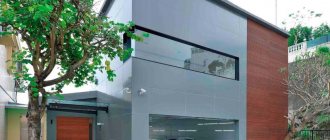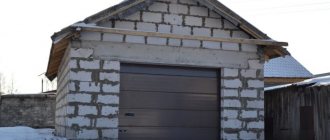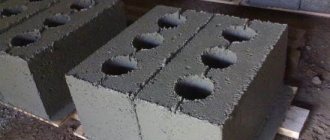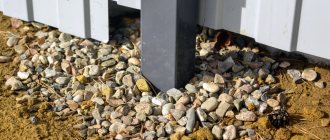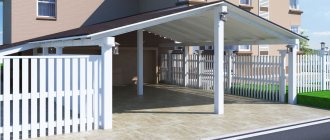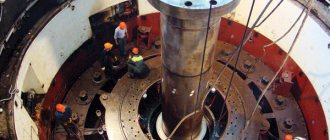Advantages and disadvantages
Having an attached car storage extension to your home has its own benefits that make it so popular. These benefits are quite simple and are as follows:
- built together with the house;
- there is no need for your own foundation and additional rafters;
- the style decision is dictated by the architecture of the house;
- the attached garage acts as an extension of the wall of the house, without standing out in any way;
- there is no need for cable channels and trenches below the ground freezing level, since electricity is supplied from a residential building;
- heating through connection to a common boiler;
- lower costs of building materials due to the fact that one of the four walls is common with the house;
- entrance through the living area.
But, with all the advantages of such a garage, there are also disadvantages that should be taken into account when making the final choice in favor of one solution or another:
- the distance between the fence and the house is unacceptable, which is less than five meters, which car owners do not always like;
- when a garage is built separately, this can lead to cracks in the walls of the house, as well as settlement of the foundation due to the lack of calculations during its construction - additional soil analysis cannot be avoided;
- the need to take into account additional vibration from machines, especially large ones;
- turning the site into a roadway due to the significant distance from the entrance gate;
- requirements for the presence of a full-fledged fire alarm and smoke detectors - fire safety rules provide for this due to the storage of fuels and lubricants in the garage;
- mandatory laying of a fire-resistant brick wall adjacent to the house;
- availability of additional output.
As you can see, most of the disadvantages of adding a garage are associated with particularly strict fire safety requirements for buildings with such an arrangement.
The durability and convenience of an additional structure of this kind depend not least on the quality of the selected materials. Before you start purchasing, answer several important questions:
- is there a need for a full-fledged garage or shelter from precipitation;
- Is there time to lay a full-fledged foundation or is a building made of lightweight materials built in a few days enough?
- is there a need for a permanent garage;
- Is saving on materials important?
Having answered them, they begin to select the main material for building walls. For a permanent garage, brick is considered the best option. Unlike cellular foam concrete, whose installation is simple but requires post-processing, it does not require this. There is no need to protect it from the corrosion that metal is susceptible to. At the same time, brickwork thicker than one-and-a-half is not needed - even that is enough to protect the car.
Do-it-yourself garage extension to a house: foundation, frame, roof, documents
Comfort is very important to most people. Especially when it comes to housing and transport. A car has long become an attribute of any busy person, because without personal transport it is impossible to have time to implement all your plans. It is necessary that a personal means of transportation is always available and at hand. That is why adding a garage to the house has become of interest to many car owners.
How to build an extension
To build a functional building to house a car as a separate structure or to build a garage attached to the house is a decision that you should know about the features of each building before making. Only professional specialists will be able to recommend anything specific depending on the customer’s goals and the initial data of the building area. To understand how to attach a garage to a house with your own hands, you need to understand all the nuances of construction.
The garage, as an extension to the house, is considered the most convenient for use. Saving money on consumables also attracts many car owners.
Choosing a location for a garage extension
When designing an extension to a garage combined with a house, you should look for a place where it will be possible to connect the necessary communications to the existing highways in the building. The garage must have all the necessary conditions for operation:
- Water supply and wastewater disposal.
- Correct electrical wiring.
- Heating system.
- Fire alarm.
You should not be negligent about installing a fire safety system in your garage. After all, a garage combined with a house is a source of increased danger, since flammable materials are stored in it.
Option for adding a garage to the front door
Having studied the plan for supplying the communications system, you need to determine its position on the territory. Also, the extension to the house must fit harmoniously into its surrounding conditions.
To understand how to properly attach a garage to a house, it is worth studying the key requirements. They must be observed when working on an object:
- The building should be located to the left or right of the main entrance to the home. One roof uniting both buildings will create a harmonious look.
- In accordance with all fire safety rules, an attached building must have two exits. One of them will be a spare one, through which in case of fire it will be possible to evacuate.
- The common wall between the house and the garage must be treated with fire-resistant agents.
- You shouldn't skimp on the foundation. Many people believe that the mass of this building is very small, so the foundation can be made shallow. It is unlikely that anyone would want to test this statement on themselves. A garage needs a solid foundation that can withstand the weight of the building itself and the car.
A combined building with a house from the point of view that heat will always emanate from the wall of the house. Also, thanks to the common door, you can easily enter the garage, even if there is bad weather outside.
Suitable materials for building a garage
Concrete block garage extension
To add a garage to your home, you need to take care of the quality of materials for its construction. It is necessary to decide what tasks the structure should perform and which of its properties will be a priority:
- strength;
- speed of construction;
- saving money and simplicity of the process.
A brick structure is considered the most reliable. The metal used in its construction saves time on construction. The disadvantage of this option is susceptibility to corrosion. This option will be most appropriate if you need to attach a garage to a brick house.
Tools and building materials
Construction work begins with the purchase of necessary materials and tools. Their set largely depends on what exactly the walls are being built from. So, for a brick building you will need cement mixtures, trowels, dowels, and hammers. And for the wooden base of the roof you cannot do without nails and a hand saw.
The construction of a garage from foam blocks, in addition to themselves, will require plaster and tools that make it possible to apply it to the walls.
Features of foundation construction
The most popular type of foundation for a garage attached to a house is a strip foundation.
The construction of the most common strip foundation consists of a number of mandatory steps:
- first of all, the area is cleared of debris;
- remove the top layer of soil with roots;
- prepare the necessary materials, in particular cement, crushed stone, sand, reinforcement and formwork;
- mark out the area for the foundation of the future garage;
- dig a trench according to a pre-developed plan;
- fill it with all the necessary materials and fill it with concrete.
The trench is dug with a standard width of 70-90 centimeters. It is important that its depth exceeds the maximum soil freezing depth in the region.
The bottom of the trench is densely covered with a mixture of crushed stone and sand and compacted thoroughly. If a vibrating plate is available, its use is also allowed. The lower layers of backfill are on average from 10 to 15 centimeters. After completing this stage, they begin to install the formwork, for which boards, sheets of plywood and stainless steel, and wooden panels are used.
In order to compensate for the concrete pressure, stops are installed on the outside of the formwork.
As soon as the formwork is installed, they begin to install the reinforcement. The reinforcement frame is assembled from metal rods with a thickness of at least 8 millimeters. They are connected to each other using strong wire or welding. It is important to prevent the reinforcement from coming into contact with the soil or coming to the surface. It is also not allowed to end at the corners, for which purpose the rods are bent using a special sheet bend. Otherwise, the frame will be subject to corrosion and will not perform its function.
As soon as the reinforcing frame is ready, they begin pouring concrete. The mixture must include fine crushed stone. Filling is done simultaneously along the entire length of the trenches, which avoids unevenness. Immediately after this, the surface is often pierced with a rod to release the accumulated air.
The concrete is allowed to harden, which depends on the weather, but takes, on average, up to a month. For complete hardening, it is covered with black construction film, which does not allow light to penetrate. To ensure uniform drying, the concrete is sprayed with water at certain intervals. As soon as it hardens, the formwork is removed.
Garage roof. Construction stages
Scheme and structure of the garage roof: 1. support board; 2. brace; 3. rafters; 4. shelf; 5. continuous sheathing; 6. waterproofing; 7. roof; 8. metal casing; 9. Bottom cladding made of boards 100x50
Certain problems can arise with the design and functioning of a garage roof. If the roof of the house is higher than the roof of the garage, precipitation flowing from the higher roof and accumulating on the lower one will cause corrosion of the surface or water entry into the interior of the garage. To prevent these processes, you should take care of good waterproofing of the garage floor and use decent material during its construction.
The roof of a garage attached to a house will especially suffer from water corrosion if it consists of iron plates - the cheapest and easiest option for garage roofing to build, but far from the most reliable. It is better to create pitched roofs from metal profiles or boards tied into sheathing. Such a roof is installed quite quickly and easily, creating all the conditions for its further covering with insulating materials.
Let's look at the construction of such a roof in stages.
- The roof itself is placed on a sheathing made from boards attached to the frame.
- The boards are laid out in a row at intervals of 10 centimeters.
- The covering of such a roof should least of all need sound and waterproofing, so the sheathing can be covered with several sheets of corrugated iron.
- The sheets are fastened with special screws on gaskets.
A garage attached to a house with the roof described above does not look like an appendage attached to a residential building, but together with it forms an integral architectural ensemble.
Construction of an extension
Construction with your own hands is a task that can be easily solved even for those who are engaged in construction for the first time. It is only important to accurately determine the type of room for storing a car, plan it correctly and comply with the requirements of government regulations. Especially regarding fire safety. Those who neglect them face problems at the registration stage.
Building brick walls is a fairly simple job. In the case of a garage, a thickness of one and a half bricks is sufficient. They are laid with the most ordinary masonry, coated with a solution.
We create a reliable roof
A shed roof is most often chosen as a solution for a garage attached to a house. This is due to several reasons. The most important of them is the more compact appearance of this design, which fits well with the nearby residential building. The second reason is simple. A shed roof is easier and faster to erect than a gable roof.
Another undoubted advantage of this roof design is the minimum required material. When calculating, the angle of inclination is taken as 20-30 degrees, adjusting in one direction or another if required by the architecture of the house. The minimum option is 10 degrees. In addition to architectural features, the precipitation situation is also taken into account. The roof must be able to withstand the maximum snowfall in the region.
When constructing roofs, preference is given to floor slabs with low thermal conductivity. This is due to fire safety requirements. Such slabs are often also distinguished by a high level of sound insulation, which is always important for outbuildings.
At the first stage of roof construction, special hanging inclined rafters are built on two supports. They are made taking into account the parameters of the garage. If we are talking about a garage up to 4.4 meters wide, the rafters will not need reinforcements - they are simply placed on supports at the desired angle and fixed. If the width of the garage exceeds the specified number, then struts are needed for reinforcement.
Next, the roofing material is placed on the rafters. To do this, use the same one that covers the roof of the house.
Gate selection
Choosing a garage door is by no means a small matter. They should be both comfortable and durable. Their correct width determines whether a car can enter the box. The space occupied by each of the common types of garage doors is also taken into account.
Today, there are mainly three types of garage doors on the market:
- swing;
- sectional;
- roller shutters
Each has its own merits. So, swing doors are a classic option. As is easy to understand from their name, they consist of doors that swing open to the sides to start the machine. The disadvantage of this design is the additional space it requires. And they can only be opened manually.
Rolling and sectional doors do not require additional space (they take up no more than the garage itself) and are controlled remotely. They are produced taking into account climatic requirements, so they are more heat and sound insulated. A special insulating material is placed between their panels.
Thanks to this, such gates will not only protect your car from frost in winter, but it will also be much easier to open them - they open upwards.
The main disadvantage of such gates is considered to be the price - it can be twice as high as that of swing gates. But recently, thanks to great competition, they have fallen significantly in price.
Construction design
To officially register an attached garage, the owner needs to have a number of documents:
- a copy of the certificate of ownership;
- a copy of the house plan;
- project of the garage itself;
- registration certificate of the house;
- project approvals.
All copies are notarized and submitted to the BTI.
What materials are needed
Many owners of country real estate are trying to figure out how to install a roof on an extension to a house. To build such a structure, it is necessary to prepare the following types of building materials:
1. A roof on an extension is impossible without the use of a component such as lumber. Coniferous wooden blocks with a cross-section of 10*10 or 15*15 centimeters are used to construct rafter legs; unedged boards are used to sheath the roof structure. When purchasing lumber, you need to pay attention to the absence of defects on its surface. These can be a variety of chips and cracks. Wood can twist when exposed to sunlight if its humidity exceeds 16%. Also, additional water in the structure of the material causes the appearance of fungus and mold. To prevent this from happening, wooden products must be treated with antiseptics.
2. The roof of the house can be covered with corrugated sheets, roofing felt or slate; the minimum cost per square meter of such products is 200 rubles. More attractive materials from an aesthetic point of view are ondulin, soft tiles or metal tiles, their price is approximately two or three times that of the analogues described above. If the extension is used to make a greenhouse or conservatory, transparent cellular polycarbonate can be used as a roofing covering.
3. Many people do not know how to connect all the roof parts together. Special fasteners are used for connection. These can be anchors, nails, screws, metal plates and corners. To calculate the number of screws, you need to multiply the roof area by 8, this is how many parts will be needed per m2 of coverage.
Please note that the roof of the extension and the roof of the main building must be covered with the same roofing material. This will achieve a perfect association between the two designs. To reduce the load on the rafters, choose a lightweight material as a coating, for example, roofing felt or corrugated sheeting; you can also use ondulin.
